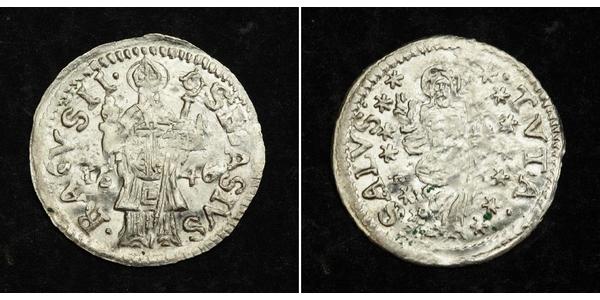(продана за $18.0)
1646, Dalmatia, Ragusa (Republic). Silver Denaric (Grosseto of 6 Soldi) Coin. XF!
Mint Period: 1646 Mint Place: Dubrovnik State: Ragusa (Republic) Reference: Mimica 801, KM-5. Denomination: Denaric (Grosseto of 6 Soldi) Condition: Lightly deformed, double-struck, otherwise XF! Diameter: 18mm Weight: 0.64gm Material: Silver
Obverse: Saint Blaise holding orb facing, splitting date (16-46). Legend: RAGVSA S BLASIVS Reverse: Christ in blessing gesture facing inside star-filled lozenge (mandrola). Legend: SALVS TUTA
Saint Blaise (Greek: Agios Vlasios) was a physician, and bishop of Sebastea, Armenia (modern Sivas, Turkey). According to his Acta Sanctorum, he was martyred by being beaten, attacked with iron carding combs, and beheaded.
St. Blaise is the patron saint of the city of Dubrovnik (where he is known as Sveti Vlaho) and formerly the protector of the independent Republic of Ragusa. At Dubrovnik his feast is celebrated yearly on 3 February, when relics of the saint, his head, a bit of bone from his throat, his right hand and his left, are paraded in reliquaries. The festivities begin the previous day, Candlemas, when white doves are released. Chroniclers of Dubrovnik such as Rastic and Ranjina attribute his veneration there to a vision in 971 to warn the inhabitants of an impending attack by the Venetians, whose galleys had dropped anchor in Gruz and near Lokrum, ostensibly to resupply their water but furtively to spy out the city's defenses. St. Blaise (Blasius) revealed their pernicious plan to Stojko, a canon of St. Stephen's Cathedral. The Senate summoned Stojko, who told them in detail how St. Blaise had appeared before him as an old man with a long beard and a bishop's mitre and staff. In this form the effigy of Blaise remained on Dubrovnik's state seal and coinage until the Napoleonic era.
The Republic of Ragusa (or Republic of Dubrovnik) was a maritime republic centred on the city of Ragusa (Dubrovnik, today in southernmost Croatia), in Dalmatia, from the 14th century AD until 1808. It reached its peak in the 15th and the 16th century before being conquered by Napoleon Bonaparte's Empire of France in 1808. It had a population of about 30,000 people, of which 5,000 lived within the city walls.
The Republic ruled a compact area of southern Dalmatia - its final borders were formed by 1426 - comprising the mainland coast from Neum to the Prevlaka peninsula as well as the Pelješac peninsula and the islands of Lastovo and Mljet, as well as a number of smaller islands off Lastovo and Dubrovnik such as Koločep, Lopud, and Šipan.
In the 15th century the Ragusan republic also acquired the islands of Korcula, Brac and Hvar for about eight years. However they had to be given up due to the resistance of local minor aristocrats sympathizing with Venice which was granting them some privileges.
In 1684, the emissaries renewed an agreement contracted in Višegrad in the year 1358 and accepted the sovereignty of the Austrian Emperor over Ragusa as a Croatian-Hungarian King, with an annual tax of 500 ducats. At the same time Ragusa continued to recognize the sovereignty of Turkey; which was nothing unusual in those days. After this even greater opportunities opened up for Ragusa ships in ports all along the Dalmatian coast, in which they anchored frequently.
In 1683 the Turks were defeated in the Battle of Kahlenberg outside Vienna. The Field marshal of the Austrian army was Ragusan Frano Dživo Gundulić/Gondola. In the Treaty of Karlowitz of 1699, the Ottomans ceded all of Hungary, Transylvania, Slavonia, Dalmatia and Podolia to the victorious Habsburgs, Venetians, and Poles.
The Ottoman Empire was no longer a threat to Christian Europe. After this, Venice captured a part of Ragusa's inland area and approached its borders. They presented the threat of completely surrounding and cutting off Ragusa's trade inland. In view of this danger and anticipating the defeat of the Turks in 1684 Ragusa sent emissaries to the Austrian Emperor Leopold in Vienna, hoping that the Austrian Army would capture Bosnia. Fortunately for the Republic, the Ottomans retained their control over their hinterland. With the 26 January 1699 peace agreement, the Republic of Ragusa ceded two patches of its coast to the Ottoman Empire so that the Republic of Venice would be unable to attack from land, only from the sea. One of them, the northwestern land border with the small town of Neum, is today the only outlet of present-day Bosnia and Herzegovina to the Adriatic Sea. The southeastern border village of Sutorina later became part of Montenegro, which has coastline to the south. Ragusa continued its policy of strict neutrality in the War of Austrian succession (1741–48) and in the Seven Years' War (1756–63).
In 1783 the Ragusan Council did not answer the proposition put forward by their diplomatic representative in Paris, Frano Favi, that they should establish diplomatic relations with the USA. Although the Americans agreed to allow Ragusan ships free passage in their ports.

|
Добавил:
anonymous 2018-07-13 |
5 Песета Королевство Испания (1874 - 1931) Серебро Alfonso X ...
в группе 6 монет / 5 цен
⇑







-300-150-ZFYKbzbiL7UAAAFIcnxXaQYp.jpg)






